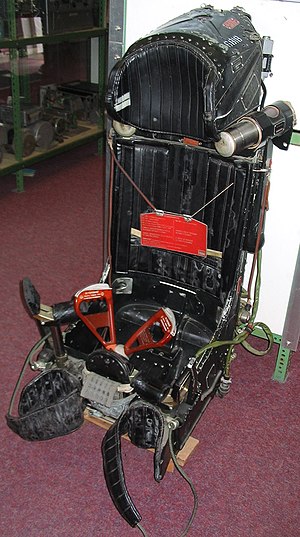NPP Zvezda K-36
| K-36 | |
|---|---|

| |
| A K-36DM Ejection seat |
The Zvezda K-36 is a series of ejection seats made by NPP Zvezda. Variants of this ejection seat have been used on a variety of aircraft, including the Su-25, Su-27, MiG-29, Su-30 MKI and the Su-57.
Design[]
The K-36 Ejection seat provides emergency escape for a crew member in a wide range of speeds and altitudes of aircraft flight, from zero altitude, zero speed (zero-zero) upwards, and can be used in conjunction with protective equipment, such as pressure suits and anti-g garments. The seat consists of the ejection rocket firing mechanism, gear box, headrest rescue system with a dome stowed in the headrest, and other operating systems all of which are aimed at providing a safe bail-out.
Operational ejections[]
Notable ejections using the K-36 occurred at the 1989 Paris Air Show when Anatoly Kvochur successfully completed a low-altitude ejection from a MiG-29 just prior to ground impact. Two more pilots survived when a pair of MiG-29s collided over Fairford, England, in 1993 at the Royal International Air Tattoo.
Variants[]
- K-36D and K-36DM: Used on the MiG-29, Su-27, Su-30[1][2][3]
- K-36D-3.5: Improved variant providing accommodation for pilots with sitting heights from 810 to 980 mm
- K-36D-5: Improved variant for the Sukhoi Su-57[4]
- K-36LM: Used in the Tu-160 Blackjack[5]
- K-36RB: Variant used on Buran programme
- K-36VM: Automatic ejection system (SKE) used successfully 20/20 times in the Yak-38[6]
References[]
- ^ Specker, Lawrence J.; Plaga, John A. "The K-36D Ejection Seat Foreign Comparative Testing (FCT) Progtam" (PDF). DTIC.mil. Defense Technical Information Center (DTIC). Retrieved 4 March 2015.
- ^ Coyne, Kevin. "The Ejection Site: K-36D Foreign Comparative Testing (FCT)". EjectionSite.com. The Ejection Site. Retrieved 4 March 2015.
- ^ Skaarap, Harold A. (2008). Canadian MiG flights. Bloomington, IN: iUniverse. p. 37. ISBN 978-0595520718. Retrieved 4 March 2015.
- ^ Butowski, Piotr. "Russian Supercruiser". Air International, February 2011, pp. 38. Stamford, UK: Key Publishing.
- ^ Duffy, Paul; Kandalov, Andrei I. (1996). Tupolev: The Man and His Aircraft (illustrated ed.). Warrendale, PA: SAE International, 1996. p. 170. ISBN 1560918993. Retrieved 2 March 2015.
- ^ Hirschberg, Michael J. (1997). Soviet V/STOL aircraft : the struggle for a shipborne combat capability. Reston, Va.: American Institute of Aeronautics and Astronautics. p. 55. ISBN 9781563472480. Retrieved 4 March 2015.
External links[]
- Ejection seats